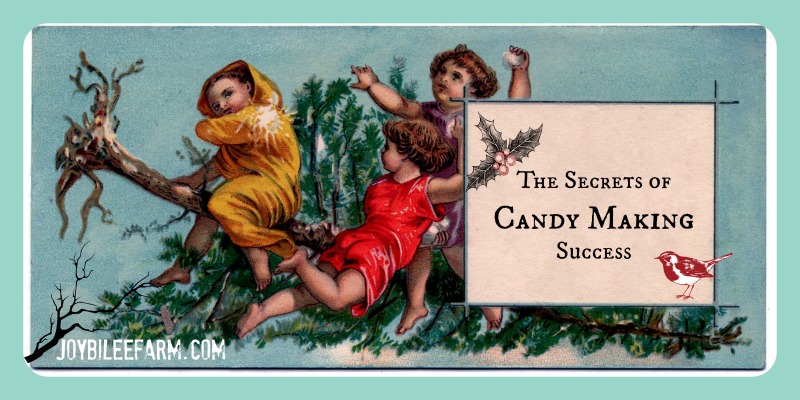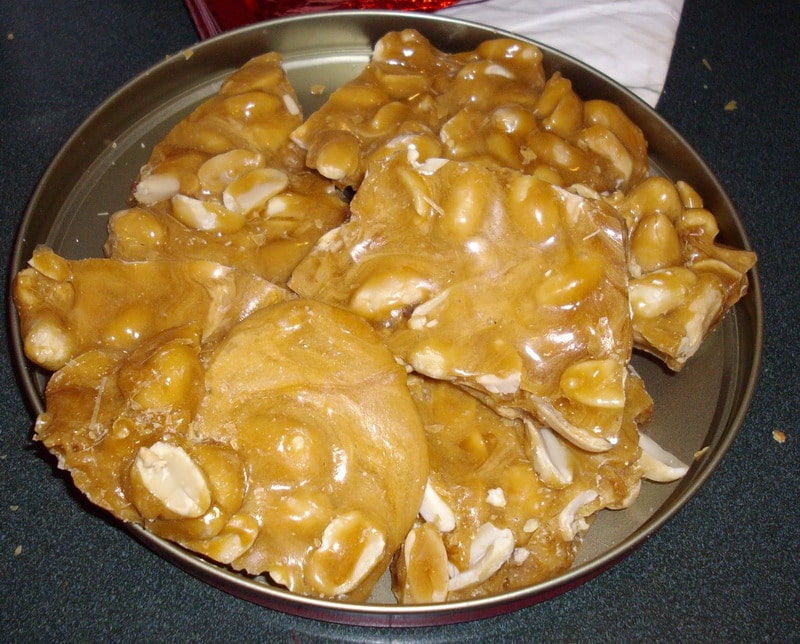Learn the candy making tips and tricks to make your holiday creations a success. Candy is an effective and fun gift for multiple occasions, can be made in good sized batches, and is easy to personalize through packaging, tags, and cards.
Candy making is both a science and an art. Getting the mixture just right can seem more like alchemy than chemistry for the uninitiated. I’ve had a few candy failures in my years of making candy for Christmas, and I’ve learned some tricks that can help you have success right from the start. So get ready to save this article for your future candy making projects and break free from the Food processors. While not exactly healthy, home made candy can be a guilt free, seasonal treat for your family.

1. Ingredients
Use the best sugar you can afford. Organic unbleached sugar or brown sugar is best. White cane sugar has been bleached but will work. Avoid beet sugar as sugar beets have been genetically modified and beet sugar doesn’t work as well for candy making.
Use honey from local bees. Avoid honey that has been super filtered so that the pollen is removed. You lose the honey flavour. Do not use corn syrup. Corn syrup is made from GM corn.

Use real butter, organic or otherwise. Do not substitute margarine for the butter. Its better to cut down on the butter in a recipe than to substitute. Margarine has GMsoy GMcanola, and GMcorn oil in it. Use real butter always. If you live in the US most milk also has GM ingredients because the cows have hormonal implants to promote milk production and growth. In Canada these implants are illegal in dairy animals. So if you live in the US and want to avoid GM ingredients, use organic butter. If you live in Canada organic butter is the best option, but at the very least use real butter.
For recipes that call for cream or whipping cream, whole farm milk both goat’s milk, sheep milk or cow’s milk, can be substituted.
Good quality chocolate — don’t use the “chocolate” melting wafers available in the bulk food section of your grocer. These are mostly sugar and wax with additives to make them smooth, and just a bit of chocolate. Instead purchase the large broken chunks of chocolate. This good quality Belgium chocolate is the ideal quality chocolate for home candy making. This chocolate contains Soy lecithin as an emulsifier. If you can find chocolate made without soy lecithin, that would be better, as soy lecithin is a GM ingredient. I haven’t found organic chocolate for melting and candy making.
2. Equipment
A candy themometer is a must. For successful candies every time you have to control the temperature.
Use a large, heavy bottomed, stainless steel pot of at least 3 litre (quarts) capacity. It needs to have straight sides to prevent boiling over. It should be 4 times as large as your syrup batch.
Measuring cups
A large stainless steel or wooden mixing spoon- don’t use plastic or teflon spoons.
A silicone spatula — plastic spatulas will melt at the high temperatures that candy making requires
A source of heat that you can control
A flat stainless steel baking sheet — not teflon coated — the coating may peel away and poison you.

3. Science behind the candy
Sugar is a sucrose molecule. It is made up of both a glucose chain and a fructose chain. When sugar is dissolved in water and then heated to high temperatures, the sucrose molecule wants to join with other sucrose molecules to form crystals. If you’ve done the science experiment where you supersaturate water with sugar and stick a string on a pencil and put the string into the solution in a glass, you’ve seen the sugar crystals form on the string. One sugar crystal seeds the others and a myriad of sugar crystals climb the string. Since sugar wants to form crystals the secrets of successful candy making involve interrupting this process.
Candy is created when sugar is heated to high temperatures. The heat removes water from the solution, and makes a super saturated solution. The higher the temperature, the less water that remains in the solution. Supersaturated solutions are unstable.
Different kinds of candy are cooked to different saturation points:
Thread Stage: 230 º F-235 º F; sugar concentration is 80%
A lot of water remains in this syrup. Use the syrup to cover ice cream
Soft-Ball Stage: 235 º F- 240º F; sugar concentration is 85%
Sugar syrup forms a soft, flexible ball. If you remove the ball it will flatten in your hand like a pancake. Fudge, pralines, fondants are cooked at this stage.
Firm-Ball Stage: 245 º F- 250 º F; sugar concentration is 87%
Sugar forms a firm ball that won’t flatten when taken out of water, but remains malleable and will flatten when squeezed. Caramels are cooked in this stage.
Hard-Ball Stage: 250º F-265 º F; sugar concentration is 92%
Sugar forms thick threads as it drips from a spoon. Sugar concentration is high which means there is less moisture. The mixture forms a hard ball when dropped into cold water. The ball will not flatten when taken out of the water. The ball will stay hard but you can change its shape by squashing it. Nougats, marshmallows, gummies, divinity, and rock candy are cooked in this stage.
Soft-Crack Stage: 270 º F-290 º F; sugar concentration is 95%
At this stage bubbles on top become smaller, thicker, and closer together. Moisture content is low. Dropped into cold water this syrup solidifies into threads that are flexible not brittle. They will bend slightly before breaking. Saltwater taffy and butterscotch are cooked to this stage.
Hard-Cracked Stage: 300 º F-310 º F; sugar concentration is 99%
This is the highest temperature that is usually seen in candy recipes. There is almost no water left in the syrup. Dropped into cold water the syrup will form hard, brittle threads that break when bent. To avoid burns, the syrup should cool in the cold water a few moments before touching it. Toffee, nut brittle, and lollipops are all cooked to this stage.
If the syrup is heated to a higher stage you will be on the way to creating carmelized sugar (the brown liquid stage) – which is added to many desserts.
Clear-Liquid Stage 320 º F; sugar concentration is 100%
Water has all boiled away at this stage. The remaining sugar is liquid and a light amber color
Brown-Liquid stage 338 º F; sugar concentration is 100%
The liquefied sugar turns brown due to carmelization. The sugar breaks down and forms more complex compounds that give the syrup a richer flavor. This is used for dessert decorations and also to candy coat nuts.
If you cook this further, the sugar will turn black and become burnt and bitter. Don’t let it get above 340F.
The crystallization of sugar happens spontaneously. Different candies require different kinds of crystallization. The hotter that the sugar solution is when it is stirred, the larger the crystals are that formed. Ideally, you want to control the crystallization to get the kind of candy that you want. If you create large crystals your candy will “seize” and it will have the texture of a sugar cube rather than candy.
All the tricks for successful candy making involve controlling the crystallization process.
For instance, fudge is made by promoting the crystallization of sugar. However, if the fudge crystallizes too soon, while the fondant is still piping hot, large crystals form and the fudge seizes and is ruined. Perfect fudge requires allowing the fondant to cool to about 110F and then beating it to form fine crystals. Impatience is the enemy of candy making.
4. High altitude candy making
Temperature adjustments need to be made for making candy at higher altitudes. For every 1,000 feet above sea level, subtract 2 degrees F from the candy making temperatures. So for instance, I live at 2,700 feet above sea level. I would subtract 5 degrees F. from the above temperatures when making candy. I would cook my almond roca recipe to 285 rather than 290F. If I cook it to 290F, my almond roca base will be more like butterscotch toffee than like almond roca, which is not necessarily a bad thing. Butterscotch toffee is one of my favourite candies.
5. The tricks of Candy Making: Controlling sugar crystalization
- The successful candy maker adds ingredients to the syrup mix that interrupts the formation of sugar crystals. Butter, Acid, Milk ingredients, and fructose from corn syrup or honey all inhibit the spontaneous formation of sugar crystals.
- Ensuring that the sugar is completely dissolved in water and that no stray sugar crystals stick on the sides of the pot, during the boiling stage, will help to inhibit the spontaneous formation of sugar crystals. You can do this by putting a lid on the pot during the initial boiling, allowing the steam to wash down the sides of the pot, dissolving any stray sugar crystals into the solution.
- You can also wash down the sides of the pot with a silicone brush and some extra water to move stray sugar crystals into solution. One stray sugar crystal will seed the mixture and promote premature crystallization of the sugar syrup.
- Don’t stir the syrup.Stirring the syrup while it is boiling promotes the formation of sugar crystals. You will need to stir it initially to dissolve all the sugar in the water and to create a supersaturated solution. But once the pot begins to boil, don’t stir it again.
- Allow the mixture to cool to the appropriate temperature before stirring or beating, ensures that the sugar crystals that form will be fine crystals, and that the candy will have a fine texture, without graininess.
- Adding an acid such as cream of tartar (aka. tartaric acid), lemon juice, or vinegar will inhibit the formation of sugar crystals.
- Control the temperature precisely. Use a candy thermometer. If you are going to do a lot of candy making invest in a steel thermometer, as the glass thermometers break easily when banged — easy to do when stored in a kitchen drawer.
- Hard candies require lower humidity, so don’t pick a day when its raining or snowing to make hard candy. The candy will absorb moisture from the air while its cooling. The best days are sunny and cold because cold air doesn’t hold as much humidity.
6. Adapting recipes
In recipes that call for corn syrup you can substitute equal amounts of honey for the corn syrup with an improvement in the taste and texture of the finished candy. Corn syrup is used because it is less expensive than honey. Only use in standard candy recipes that go up to hard crack stage, honey can burn easier than corn syrup.
Brown sugar can be substituted for white granulated sugar.
Tapioca or potato starch can be substituted for corn starch in recipes calling for starch. Corn starch contains GM corn derivatives.
Icing sugar can be made by blending granulated white sugar in a blender with potato or tapioca starch.
To substitute white sugar for brown sugar add 2 tbsp of molasses per 1 cup of white sugar that you use.
Whole milk can be substituted for cream or whipping cream.
If a recipe calls for an acid, such as cream of tartar, you can substitute another acid such as lemon juice or vinegar.
Do not substitute margarine in recipes calling for butter. Margarine has a higher water content than butter. The liquid vegetable oils used in margarine production are damaged, forming free radicals, when margarine is heated to high temperatures. This will affect your candy.
100 year old Recipe: Maple Walnut Fudge
So to test you new knowledge here’s my family’s 100 year old fudge recipe to try:
2 1/2 cup white sugar
2 1/2 cup brown sugar
2/3 cup honey
2 tbsp. butter
1 cup of goat’s milk or whole cow’s milk
2 tsp. vanilla extract
1 cup of walnut or pecans, broken
Mix sugars, honey, milk and butter in a heavy sauce 6 quart sauce pan. Stir to dissolve sugars. Boil with lid on for 5 minutes, over medium heat. Remove lid. Using a silicone brush and a cup of water brush down the sides of the pot to remove any residual sugar crystals. Do not stir once mixture has begun to boil. Insert candy thermometer. Cook to 240 degrees F. Remove from heat. Without stirring allow to cool to 110 degrees F. This process can be speeded up by placing pot in a sink of cold water. Watch the temperature carefully. While mixture is cooling prepare a 10 x 14 glass pan, by buttering sides, corners and bottom.
Once the mixture has cooled to 110F, add the nuts and the vanilla. Begin to beat the mixture with a wooden spoon or a hand beater. This will encourage the formation of fine crystals that give fudge its characteristic texture. Beating too soon will cause large sugar crystals to form and for the fudge to seize. Waiting until it reaches 110F will ensure that only fine crystals form. As you beat the fondant, the colour will lighten and the fondant will become glossy. Pour it into the pan as it begins to stiffen, but before it gets too stiff. Spread it out and let it get firm. While it is still warm, cut it into squares. Then allow to cool completely.
You can change the fudge flavours by adding melted chocolate, espresso power, different flavouring extracts, or different nuts at the stage where the fudge has cooled to 110F. The key to success is to allow it to cool to 110F undisturbed and then beat it well, pouring it just as it begins to stiffen.
Print
Maple Fudge
- Prep Time: 20 min
- Cook Time: 60 min
- Total Time: 80-90 min
- Yield: 3 lbs 1x
Description
Maple fudge for your Christmas candymaking fun.
Ingredients
- 2 1/2 cup white sugar
- 2 1/2 cup brown sugar
- 2/3 cup honey
- 2 tbsp. butter
- 1 cup of goat’s milk or whole cow’s milk
- 2 tsp. vanilla extract
- 1 cup of walnut or pecans, broken
Instructions
- Mix sugars, honey, milk and butter in a heavy sauce 6 quart sauce pan.
- Stir to dissolve sugars.
- Boil with lid on for 5 minutes, over medium heat.
- Remove lid.
- Using a silicone brush and a cup of water brush down the sides of the pot to remove any residual sugar crystals.
- Do not stir once mixture has begun to boil.
- Insert candy thermometer. Cook to 240 degrees F.
- Remove from heat.
- Without stirring allow to cool to 110 degrees F.
- This process can be sped up by placing pot in a sink of cold water.
- Watch the temperature carefully.
- While mixture is cooling prepare a 10 x 14 glass pan, by buttering sides, corners and bottom.
- Once the mixture has cooled to 110F, add the nuts and the vanilla.
- Begin to beat the mixture with a wooden spoon or a hand beater.
- This will encourage the formation of fine crystals that give fudge its characteristic texture.
- Beating too soon will cause large sugar crystals to form and for the fudge to seize. Waiting until it reaches 110F will ensure that only fine crystals form.
- As you beat the fondant, the colour will lighten and the fondant will become glossy.
- Pour it into the pan as it begins to stiffen, but before it gets too stiff.
- Spread it out and let it get firm.
- While it is still warm, cut it into squares.
- Allow to cool completely.
Notes
You can change the fudge flavours by adding melted chocolate, espresso power, different flavouring extracts, or different nuts at the stage where the fudge has cooled to 110F. The key to success is to allow it to cool to 110F undisturbed and then beat it well, pouring it just as it begins to stiffen.
Check out how commercial candy canes are made:
Resources:
More Sustainable Christmas Stocking ideas — a list of candy recipes
A lesson plan for hands-on chemistry through candy
A recipe for Candy Canes (this is a pulled toffee) These are chewier than traditional candy canes, but still tasty.
Buckeye Bark (A peanut butter cup with a twist)
Back to You:
What is your favorite homemade item to include as gifts, or in stockings? Leave a comment, I love to hear from you.
If you are looking for ways to DIY Christmas gifts and make happy Christmas memories while living within the health and budget constraints that have been handed to you this year, I created a resource that will help.
This DIY Christmas Planner workbook will help you make a solid plan you can live with for a Happy Holiday season. You’ll find inspiring DIY gift ideas, space to reflect on what is important to you, and a place to set goals for bringing a happy and meaningful Christmas to your family this year.
Get on Santa’s Permanent Nice list by staying organized, calm, and in control this Christmas Season.




You need both glucose and sucrose to make candy. Sugar contains both. I’m not sure about these other syrups that you mention as I’ve never used them. But if you try this let us know your results.
Hi! Thank you for this. Super helpful. So if we’re making a hard candy with honey, would it be possible to not use white sugar but to use tapioca syrup for example? Or even brown rice syrup? Thank you so much!